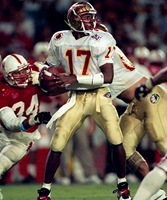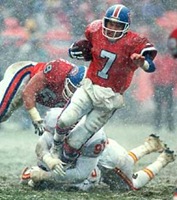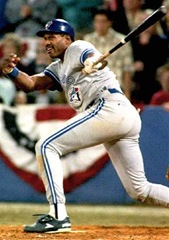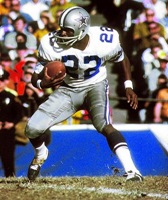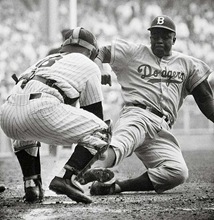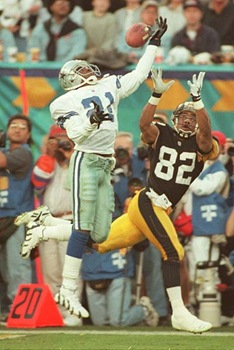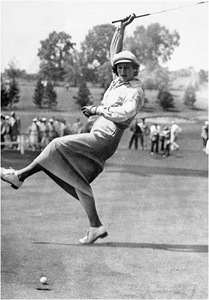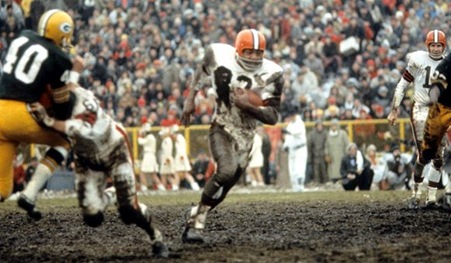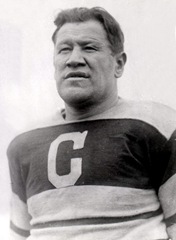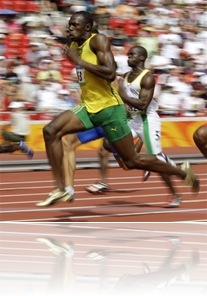
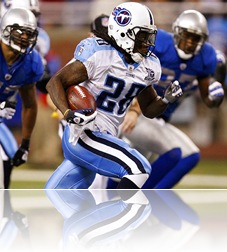
Updated 5/15/10
For a moment, it looked like this race would happen. But, apparently a disagreement over the distance killed the proposed race between Jamaican Olympic sprinter and multiple world record holder Usain Bolt and Tennessee Titans running back Chris Johnson to determine the world’s fastest human; Johnson wanted to run 60 yards or less and Bolt wanted to run a longer race.
Bolt won three gold medals at the 2008 Summer Olympics in Beijing, setting world records in the 100 meters and 200 meters and sharing a third world record with the Jamaican 4x100 meter relay team. At last year's world championships, he shattered both of his own sprinting world records, running the 100 meters in 9.58 seconds and the 200 meters in 19.19 seconds. Bolt is widely considered the fastest man in the world…
Watch Usain run really fast.
Chris Johnson begs to differ.
During 2009, Johnson became the NFL's sixth 2,000-yard rusher when he completed his season with 2,006, breaking Earl Campbell's franchise record of 1,934. The second-year back from East Carolina also broke Marshall Faulk's NFL single-season record with 2,254 total yards from scrimmage.
At the 2008 NFL scouting combine, Johnson was timed in the 40 yard dash at 4.24 seconds -- the fastest time clocked at the combine that year.
Jimson Lee wrote a very interesting article in SpeedEndurance.com comparing the different physical demands of a 40 yard dash versus a 100 meter sprint and how one cannot just look at a sprinter’s split time to extrapolate their 40 time. Lee explains:
“In the 100m, you accelerate as long as possible to reach top speed, then maintain top speed. You want to cover the distance in the shortest possible time.
The 40 yard dash is similar: your goal is to get to the 40 yard line as fast as possible from a motionless position. You have to overcome inertia, then reach top speed as fast as possible.
The “problem” is World class sprinters take longer to reach top speed because they have a longer acceleration phase. (In reality, the “problem” is a nice thing to have, right?)
Novice 100m runners and female sprinters will reach their top speed sooner, so more of their race will be speed endurance (NOTE to Coaches – worry less about their reaction time and starting blocks, and focus on acceleration and speed endurance. Why work on improving 0.10 seconds when you can improve 1.0 seconds?)
It’s really unfair to use their actual 100 meter race splits and extrapolate their 40 yard dash time AS THEIR TRUE POTENTIAL. Why? Because the extrapolated 40 yard dash time is merely an extrapolation or "split en route" to a 100 meters.
Everyone is familiar with the different phases of a 100 meter sprint: reaction time, acceleration, transition, maintenance.
Based on the real splits, especially the 30-40m split where the 40 yard lies, they have yet to reach their top end speed.
But what would happen if they "trained seriously" for the event and reached their top speed earlier?
What if Ben Johnson or Usain Bolt trained to run the 40 yard dash (or 36.6 meter dash) as if it was a real event? Some Most football players treat the 40 yard dash as if it were a real event. A good or bad 40 yard dash time can make or break a football combine.
And finally, what if you subtracted 0.24 from their FAT time to downward convert it to a hand time?
We are looking at 3.9 to 4.0 hand time performances!
In my example, we are ASSUMING world class sprinters can reach top speed at 30m, and not between 50-60 meter mark.
(Editor’s note: “Ben”=Ben Johnson; “Carl”=Carl Lewis; “Mo”=Maurice Greene; “Tim”=Tim Montgomery; “Asafa”=Asafa Powell; etc.)

Thus, to calculate a true 40 yard dash potential:
- reaction time is not considered
- the 0-10m segment is the same as the 100 meters (Phase 1)
- the 10-20m segment is an average speed of the 10-30m segment in a 100m (Phase 2)
- the 20-30m segment is an average speed of the 30-50m segment in a 100m (Phase 3)
- the last 6 meter segment is a pro-rated speed of their top end speed (50-60m) in a 100m (Phase 4)
You can mix and match the distances and phases around to add up to 40 yards. The chart is a fun illustration for discussion purposes. If the 4 phases are equal, then I would calculate using 9.15m splits to equal 36.6 meters.”
GAME Context. So what is the point of going through this mental exercise of who is the fastest? I have to admit personal curiosity is a big reason. Most people I asked, wanted to see this race and it’s easy to see why.
Speed is a fundamental metric used when comparing athletes in almost any athletic endeavor; especially when comparing athletes from different sports. Theo Walcott could the fastest footballer in the world, but could he beat Bryan Habana, arguably the fastest rugby union player in the world? Could any of them beat Bolt or Chris Johnson? We don’t see athletes from different sports performing with or against each other, so fundamental questions like “who is the fastest athlete in the world” will always exist.
Addressing such questions is partly the reason why THE GAME matters.
There is no context nor platform that currently exists in which questions such as “who is the ___est” can be assessed, much less answered. The goal for THE GAME is to become a universal platform in which (at least in this example, athletic) talent can be compared to other talent no matter what the nodes are.
So, what are nodes? Here’s an excerpt from a previous article on the subject:
“The building blocks of THE GAME are nodes. The concept of the node has evolved over time, but the essence of the node and its role in THE GAME has not changed. In its most basic form, nodes are the individuals/groups, places, objects/things, ideas, traditions, discussions, created works, competitions, etc. that are found in cultures and remixed by those in the cultures. THE GAME borrows these nodes; reshaping or “tweaking” them to fit into, if not already, the context of a competition. Nodes enable groups and individuals to create and continually transform the content of THE GAME competition(s).
When an existing competitive or cultural node has been integrated into THE GAME, it is transformed into a GAME node (or G node) which can in turn be spun back into cultures for consumption and/or reintegrated into THE GAME. This process allows THE GAME to recombine and mashup its contents and perpetually reshape and transform itself.
On the surface, it seems THE GAME would be difficult to follow and participate in since it appears to be in a state of constant flux. However, THE GAME is like an expanding universe in that at its center are an interconnected network of known nodes and known G nodes that remain relatively unchanged (and have an established following). On the frontiers of the expanding universe, THE GAME can recombine its constituent nodes and/or create newer nodes and newer G nodes from existing nodes or nothing at all. People could choose to follow certain sections of the “established” GAME or follow the “fringes” of THE GAME where new nodes and G nodes are being developed and integrated….
A mixed node can be a blend of two or more separate nodes forming an entirely new blended (hybrid) node or a linked node consisting of two or more nodes that are not completely blended but exist in two simultaneous forms—their constituent nodes and the new node created by linking, but not completely integrating the constituent nodes (preserving the integrity of the constituent nodes).”
Using this framework of nodes and G nodes, in what ways can Usain Bolt, Chris Johnson, Theo Walcott, Bryan Habana and whomever else, “play together” or against each other by linking up, but not completely blending their respective nodes together?
Here’s a preliminary framework for one option using our, now familiar, American football and sprinting nodes:
1. sprint zones on the wings: running parallel to the football field lengthwise and on either side (wings) of the football field are sprint lanes (zones).
If a GAME team decides to score bonus points by utilizing its sprinters in the sprint zones on the wings, the football unit must time its play so a mesh point between a sprinter and football player is executed immediately after the sprinter crosses his sprint finish line, and while staying in his lane and maintaining top-end speed, receives the football (via a forward pass, handoff or pitch) or a baton in a 20 meter “catch zone”. For a sprinter to score for his GAME football team, he must cross the finish line of the “catch zone” first.
In this linked node, sprinters have a dual role in the sprint zones on the wings. Their man focus is winning their sprint race (and be the first person to cross the finish line); their secondary focus is to immediately transition into a receiver after crossing the finish line (and be the first person to cross the “catch zone” finish line) in order to score the maximum number of points for their GAME football team.
Each sprinter in the race is assigned points through a yet to be determined point value system that factors in the sprinter’s lane assignment (the further the sprint lane is from the football field the more points are awarded) and their personal “point index” (determined by a sprinter’s record for his sprint season). The winner of the race will give his GAME team the number of points determined by the point value system. The other sprinters in the race will serve as additional receiver options for the offensive team or sprint defenders (the sprinters defenders must stay in their lane and not interfere with catching the football, however). Pregame heats will determine the number of sprint receivers and sprint defenders the GAME teams will have in the sprint races on the wings.
2. sprint relays (transition from a football to a sprint relay baton): clearly marked and delineated inter-nodal transition zones between football fields and sprint tracks are positioned for 4 x 100 meter relays, 4 x 400 meter relays, 4 x 800 meter relays, etc. A sprinter will start with a baton in a relay race. Mesh points between sprinters and football wideouts, W or B will occur only on certain parts of the field of play. A team will therefore only have a limited number of opportunities to pull off the handoff between sprinting and football nodes. One scenario can be as follows:
-handoff #1: sprinter #2 enters an inter-nodal transition zone; on a predetermined playcall, the sprinter will drop the baton and take a football handoff from a streaking W or B. The proposed football, using an advanced computer chip and air cell technology, will transform its shape into a baton when in the transition zone. The defenders on the W or B on the field and transition zones are not allowed to defend against the sprinters (in other words impede their progress) in the sprint lanes. Only sprinters can be defenders against sprinters.
-handoff #2: sprinter #2 hands off the football baton to sprinter #3
-handoff #3: sprinter #4 takes the final handoff and streaks to the finish line. His sprint relay team must finish in the top three for his GAME football team to receive any points. The points awarded would be determined by the rules of the linked node.
The GAME flow in option one: Transitional handoffs to a sprinter are an opportunity to collect more points on the same drive for a GAME team. A GAME football team may decide to handoff to a GAME sprinter or a relay team who may ultimately finish first. The team represented by the winning sprinter(s) will be awarded the maximum points allowed for a successful transition. However, when a GAME team chooses to transition to a sprinter, its football team will lose a down and the football will be marked at the spot of the attempted transitional handoff. Even if its sprinters lose a race, the football team, assuming they are not out of downs, can continue its football drive from the point of the ball’s spot for points.
A sprint team’s goal is to finish first in their node race and then get points for their GAME team. The sprinter’s primary focus is his sprinting. If a transitional handoff fails between a sprinter and football player, the sprinter can remain alive in his race (if the football baton is dropped in the “transition zone” or “catch zone” the sprint race or sprint relay baton remains alive). The key: the SC, QB, ThB, W and/or B must hit the sprinter with a pass, handoff or pitch while the sprinter is in full stride.
The option one systems are perfect for sprinters with football backgrounds. Some notable athletes that could fit these types of systems include Ron Brown, Rocket Ismail, Herschel Walker, Willie Gault, Renaldo Nehemiah, Bob Hayes, Jim Thorpe, Sam Graddy and Ted Ginn, Jr..
Here’s option two still using our examples of American football and sprinting nodes:
Option two involves node mesh points between sprinters and football players without utilizing a direct exchange between these athletes. This is the preferred mode of exchange between sprinters and football players when the sprinter does not have a background in football.
One scenario can be as follows:
A football team scores a touchdown and now has several extra point options: attempt a 2 point conversion, kick an extra point or its sprinter wins a sprint contest to receive an additional 4 points (or however many points the particular linked node awards) to their total. When the offensive team scores a touchdown, the sprinters must get ready to race. The composition of the sprint field is determined by prerace/pregame heats. The scoring team may have as many as 3 (or as mentioned before, as many sprinters as the rules of a particular hybrid node allows) sprinters in the field. Each sprinter can only be used once in each quarter so a stable of sprinters should always be at the ready to keep everyone fresh. A team can have a certain number of sprinters representing them per event and the sprinters will go though prerace/pregame heats to determine how many will advance to the final heats
(during the Game). The opposing team will have its sprinters go through the exact same process. The sprinting defenders will defend the 4 point conversion try by trying to win the sprint race. If the sprinters for the defending GAME team wins the race, the 4 point conversion attempt will have failed for the team scoring the touchdown and the scoring team will be awarded no extra points.
It is anticipated that GAME teams will be allowed a certain amount of salary space for their stable of sprinters. By having a salary cap, GAME teams with less capital can compete with GAME teams with more resources and prevent a small number of well financed teams from hording the world’s elite sprinters.
Option three could utilize “hot spots” located anywhere on the football field. Receivers must catch the football in these designated “hot spots” to have a chance for their sprinter(s) to run as in option two. To “activate” its sprinters, a GAME football team must hit a receiver in a “hot spot” and score on that same drive.
Remember this is only a preliminary framework of various options and more details will be needed to officially launch these Games. In related future posts we will include more diagrams, pictures and details outlining these options. In the meantime we will reference this post on THE IdeaBOARD for continued planning and discussion.



